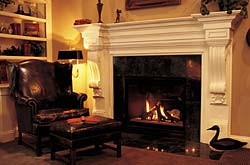Home Heat Exchangers and Steam Heat
See if We Have Top-Rated
Heating Contractors in Your Area

Whether it is in a home, automobile, or being used in an industrial setting, the job of a heat exchanger is the same: to control the transfer of thermal energy. While the most impressive forms of the heat exchanger are generally found in places like nuclear power plants, they also play a significant role in many residences.
Heat Exchangers around the Home
In a home, a heat exchanger can be used to transfer the heat created by burning fossil fuel to water or air that is then pumped throughout the house. Heat exchangers can also play a role in some air conditioning units and refrigerators. There are heat exchangers for hot tubs, pools, or you might even heat the water for your shower.
Types of Heat Exchangers
To describe how a particular style of heat exchanger works would become quite technical and might require diagrams, equations, and the like. The basic differences between the varieties of heat exchangers the average person comes into contact with are based in form and appearance rather than basic principles. A coil heat exchanger works on the same principles as a plate or shell-and-tube variety. Their form, however, makes one preferable to another in a given situation.
In a coil heat exchanger, a small tube is wound in a tight spiral and is placed inside of a larger tube (think of a Slinky inside of a Pringles container). The small tube is filled with a liquid that is a significantly different temperature than the liquid in the tube that surrounds it. As the liquid makes its way through the small tube, thermal energy is gradually transferred so as to bring the temperatures of the two liquids closer together.
Don't be left in the cold! Use this link to
Install Central Heat Steam Heat
A radiator in a home that uses steam heat is much like a coil type heat exchanger with the radiator as the Slinky and a room of the home as the Pringle's can. A boiler heats water until it becomes steam. The steam passes through the coils of the radiator, from one end to the other. As it passes through, the steam gives its heat to the air around it. At the end, of its journey, the steam condenses back into water and is brought back to be boiled again.
The efficiency of steam heat and hot water heat (which behaves in pretty much the same way, except the water experiences no change from liquid to vapor) has long been used in Europe and the northeastern U.S. It is gaining popularity in new construction all over America today because of both its effectiveness, as well as (and perhaps more importantly) the comfortable feel of the heat it makes.
Many central heating systems in this country use forced air. While fairly efficient, the heated air that is produced by these systems is very dry and is much less comfortable for some people. Forced air systems are less expensive to install in a new construction than a hot water or steam system because of the high cost of the radiators. In the long run, however, the steam and hot water systems are more efficient.
More Tips & Advice For Your Home
- Recent Articles

